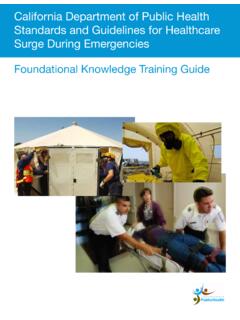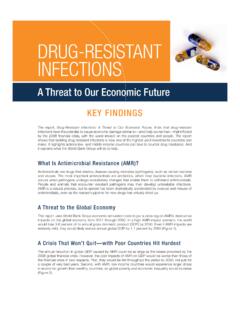Transcription of CIDRAP Antimicrobial Stewardship Project POLICY UPDATE ...
1 Page | 1 CIDRAP Antimicrobial Stewardship Project POLICY UPDATE JANUARY 2017 This is the third UPDATE in a series focusing on current POLICY issues regarding Antimicrobial Stewardship and antibiotic resistance. Our first UPDATE highlighted regulatory and voluntary initiatives aimed at enhancing Antimicrobial Stewardship in US hospitals and long-term care facilities; our second focused on antibiotic Stewardship in outpatient healthcare. This UPDATE summarizes recent initiatives aimed at enhancing antibiotic Stewardship in animal production. As always, we welcome feedback and discussion, including your suggestions for topics to explore in future POLICY updates. If you have comments or questions, please e-mail the CIDRAP -ASP staff at Antimicrobial Stewardship in Animal Agriculture Antimicrobial Stewardship is a critical strategy to preserve available treatment options and slow the loss of effective antibiotics due to bacterial resistance (Spellberg 2013).
2 Stewardship principles extend to veterinary medical practice and animal agriculture, in which a wide range of antibiotic drugs important to human medicine are used. By volume, the vast majority of antibiotics worldwide are sold for veterinary purposes, predominantly in large-scale operations for production animals such as dairy and beef cattle, swine, chickens, and turkeys, and in aquaculture (Flynn 2016; Wall 2016). Antibiotics are critical drugs for treating illness in production animals; they are also commonly used to prevent the spread of disease and to promote growth, typically through the use of subtherapeutic doses for extended periods a practice that creates ideal conditions for accelerating Antimicrobial resistance (AMR).
3 In this way, possible misuse or overuse of medically important antibiotics in animal production is considered to be a clear and substantial driver of AMR, even though there are gaps in data on the magnitude of the risk and specific mechanisms for transmission of antibiotic resistant bacteria or genes from animals to humans, such as through food distribution, environmental contamination, or contact with farm animals (Wall 2016; Robinson 2017; Holmes 2015; Robinson 2016; Al -Tawfiq 2016). Routine antibiotic use in animals for disease prevention and/or growth promotion is also viewed as a major modifiable factor in reducing AMR. A number of recent reports have published POLICY recommendations for enhancing antibiotic Stewardship in animal agriculture, aimed primarily at integrated, multisectoral efforts to reduce or eliminate the nontherapeutic use of medically important antibiotics.
4 These recommendations are summarized below in Table 1. Table 1. Summary of Selected Recent POLICY Recommendations Pertaining to Antibiotic Stewardship in Animal Agriculture Source POLICY Recommendations Review on Antimicrobial Resistance. tackling drug - resistant infections globally: final report and recommendations (May 2016) [Full text] Establish 10-year targets at the country level for reducing unnecessary use of antimicrobials, taking into account countries production systems and economic development, with support from the World Health Organization (WHO), the Food and Agriculture Organization (FAO) of the United Nations, and the World Organization for Animal Health (OIE) in the design, implementation, and review of progress.
5 Harmonize a list of critical, last-line antibiotics in human medicine that should be restricted from use internationally in animal agriculture. Improve transparency regarding information on antibiotics used in food production. Page | 2 Improve collection and use of surveillance data on antibiotic use in agriculture and the spread of drug - resistant microbes among food animals. Analyze costs of reducing the use of antibiotics in farming, particularly in low- and middle-income countries (LMICs). Center for Disease Dynamics, Economics & POLICY (CDDEP). Antibiotic use and resistance in food animals: current POLICY and recommendations (2016a) [Full text] Track rates of veterinary antibiotic use, resistance, and residues through nationwide surveillance and monitoring systems (focusing on India, currently one of the top consumers of agricultural antibiotics worldwide, with use expected to double by 2030).
6 Change incentives to discourage unnecessary antibiotic use in animals. Educate farmers, veterinarians, and consumers about Antimicrobial resistance (AMR). Phase out the subtherapeutic use of antibiotics in animal agriculture. rdal C, Outterson K, Hoffman SJ, et al. International cooperation to improve access to and sustain effectiveness of antimicrobials. Lancet 2016 Jan 16;387(10015):296-307 [Abstract] At the national level, reduce or eliminate antibiotic use for growth promotion or prophylaxis in animals, coupled with (1) adequate investment in infection prevention and control interventions in livestock and for other agricultural uses, (2) effective mechanisms to remunerate veterinarians and prescribers while limiting their ability to profit from Antimicrobial sales and reorienting their roles away from commercial gains, and (3) further research into the implications of this POLICY in LMICs.
7 At the global level, form a coalition of key countries to lead the way in restricting specific classes of antimicrobials for human use only; countries should work with the World Trade Organization to transition away from using antibiotics for growth promotion or prophylaxis, using health and sanitary/phytosanitary exceptions under trade agreements. Food and Agriculture Organization (FAO) of the United Nations. The FAO action plan on Antimicrobial resistance, 2016-2020 (Sep 2016) [Full text] Improve awareness of AMR among food and agriculture stakeholders and integrate AMR issues into food and agriculture POLICY -level discussions. Develop capacity for country-specific integrated surveillance and monitoring of AMR and Antimicrobial use in food and improve laboratory capacity to monitor AMR and detect Antimicrobial residues in food products.
8 Strengthen governance related to Antimicrobial use and AMR in food and agriculture. Promote good practices in food and agricultural systems and the prudent use of antimicrobials, eg, by adopting at the country level international standards and guidelines relevant to addressing AMR, improving awareness and knowledge about responsible use of antimicrobials in food and agriculture sectors, and improving biosecurity, good practices, and other measures to support prudent use of antimicrobials throughout the food chain. Wellcome Trust. Evidence for action on Antimicrobial resistance (Sep 2016) [Full text] Phase out, as rapidly as possible, antibiotic use in agriculture without compromising the food system s capacity to meet increasing global demand.
9 Replace the use of antibiotics for growth promotion and disease prevention with improved animal husbandry practices. Conduct research to identify alternative treatments and husbandry practices and improve their implementation globally. Develop innovative insurance mechanisms for food producers to mitigate economic risks associated with transitioning to new antibiotic Stewardship practices. Develop and deliver Antimicrobial Stewardship education and training programs targeted at veterinarians, farmers, and others responsible for animal health. The feasibility of specific types of interventions to achieve these goals may vary by country or region. In 2006, the European Union (EU) banned the use of medically important antibiotics as animal growth promoters, and in 2016, China announced that the use of colistin (a last-line antibiotic used to treat multidrug- resistant gram-negative bacterial infections in humans) as a growth promoter (feed additive) in animals would be replaced by non-human antibiotics (Walsh 2016; Al-Tawfiq 2017).
10 In 2013, the United States began a 3-year transition to regulatory restrictions on the use of antibiotic agents in animals for growth promotion (see below). In low- to middle-income countries (LMICs), alternative policies and mitigation strategies may be needed because of economic challenges as well as rapidly increasing demands for animal protein. Page | 3 Robinson and colleagues (Robinson 2017) identified a number of pragmatic, near-term interventions in LMICs that could be considered, including the following: Enhancing management and biosecurity innovations Using non-antibiotic growth promoters (eg, enzymes, competitive exclusion products, probiotics, and prebiotics) and/or other animal health technologies (eg, vaccines, vector control, bacteriophages, and disinfectants)















